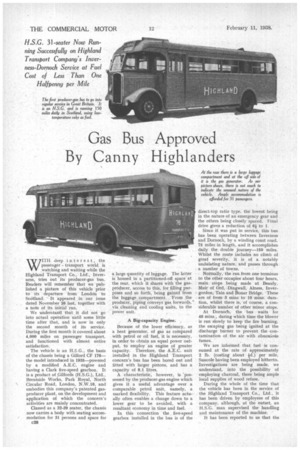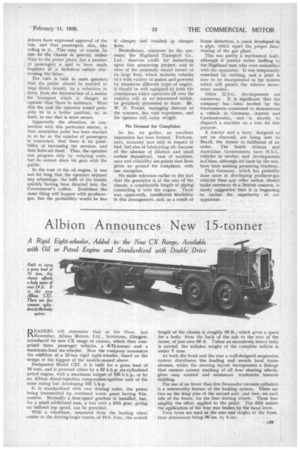Gas Bus Approved By Canny Highlanders
Page 78

Page 79

If you've noticed an error in this article please click here to report it so we can fix it.
' ITH deep interest, the watching and waiting while the Highland Transport Co., Ltd., Inverness, tries out its producer-gas bus. Readers will remember that we published a picture of this vehicle prior to its departure from London to Scotland. • It appeared in our issue dated November 28 last, together with a note of its initial run.
We understand that it did not go into actual operation until some little time after that, and is now in only the second month of its service. During the first month it covered about 4,000 miles on passenger transport, and functioned with almost entire satisfaction.
The vehicle is an H.S.G., the basis of the chassis being a Gifford CF 178— the model introduced in 1935—powered by a modified A.E.C. engine and having a Clark five-speed gearbox. It is a product of Pilfords (H.S.G.), Ltd., Brentside Works, Park Royal, North Circular Road, London, N.W.10, and embodies this company's patented gasproducer plant, on the development and application of which the concern's activities are mainly concentrated.
Classed as a 32-39 seater, the chassis now carries a body with seating accommodation for 31 persons and space for c2.8
a large quantity of luggage. The latter is housed in a partitioned-off space at the rear, which it shares with the gas. producer, access to this, for filling purposes and so forth, being gained from the luggage compartment. From the producer, piping conveys gas forwards, " via cleaning and cooling units, to the power unit.
A Big-capacity Engine.
Because of the lower efficiency, as a heat generator, of gas as compared with petrol or oil fuel, it is necessary. in order to obtain an equal power output, to employ an engine of greater capacity. Therefore, the A.E.C. unit installed in the Highland Transport concern's bus has been bored out and fitted with larger pistons, and has a capacity of 8.1 litres.
A characteristic, however, is 'possessed by the producer-gas engine which gives it a useful advantage over a comparable petrol unit, namely, a marked flexibility. This feature actually often enables a change down to a lower gear to be avoided, with a resultant economy in time and fuel.
In this connection the five-speed gearbox installed in the bus is of the
direct-top ratio type, the lowest being in the nature of an emergency gear and the others being closely spaced. Final drive gives a reduction of 61. to 1.
Since it was put in service, this bus has been operating between Inverness and Dornoch, by a winding coast road, 75 miles in length, and it accomplishes daily the double journey-150 miles. Whilst the route includes no climb of great severity, it is of a notably undulating nature, and passes through a number of towns.
Normally, the run from one terminus to the other occupies about four hours, main stops being made at Beauly, Muir of Ord, Dingwall, Mness, Invergordon, Tain and Bonar Bridge. These . are of from 3 mins to 10 mins. duration, whilst there is, of course, a considerable number of other minor stops.
At Dornocia, the bus waits for 40 mins., during which time the blower is run slowly to keep the fire burning, the escaping gas being ignited at the discharge burner to prevent the contamination of the air with obnoxiods fumes_ We are informed that fuel is consumed at the rate of approximately 2 lb. (costing about id.) per mile. Suncole having been employed hitherto. Investigations are being made; we understand, into the possibility of employing charcoal, there being ample local supplies of wood refuse.
During the whole of the time that the vehicle has been in the service of the Highland Transport Co., Ltd., it has been driven by employees of this company, although, at the outset, an H.S.G. man supervised the handling and maintenance of the machine.
It has been reported to us that the drivers have expressed approval of the bus, and that passengers, also, like riding in it. This may, of course, he due to the chassis in general, rather than to the power Plant, but a number . of passengers is said to have made inquiries of a technical nature concerning the latter.
The .view is held in some quarters that the public should be enabled to . reap direct benefit, by a reduction in fares, from the introduction of a means for transport which is cheaper to operate than those in existence. Were this the case the operator would probably be in a better position, or, at least, in one that is more secure.
Apparently the situation, in connection with this particular matter, is that saturation point has been reached in so far as the number of passengers is concerned, that there is no possibility of increasing the services, and that fares are fixed. Thus, the operator can progress only by reducing costs, but he cannot share his gain with the public.
In the ease of the oil engine, it was not for long that the operator enjoyed any advantage, the bulk of the benefit quickly having been directed into the Government's coffers. Doubtless the same thing will happen with producergas, but the probability would be less if cheaper fuel resulted ip cheaper fares.
Nevertheless, whatever be the outcome, the Highland Transport Co., Ltd., deserves credit for embarking upon this pioneering project, and in view of the unusually mixed nature of its large fleet, which includes vehicles of a wide variety of 'Fakes and powered by numerous different types of engine, it should be well equipped to form the conclusions which operators all over the country will, is we mentioned earlier, be genuinely interested to learn. Mr. W. H. Friwke, managing director of the concern, has vast experience, and his opinion will carry weight.
No Ground for Complaint.
So far, we gather, an excellent impression has been formed. Performance, economy (not only in respect of fuel, but also of lubricating oil,-because of the absence of dilution and small carbon deposition), ease of maintenance and reliability are points that have given no ground for complaint, with one exception.
We made reference earlier to the fact that the generator is at the rear of the chassis, a considerable length of piping connecting it with the engine. There was, apparently, insufficient flexibility in this arrangement, and, as a result of frame distortion, a crack developed in a pipe, which upset the proper functioning of the gas plant.
This was purely a mechanical fault, although it proved rather baffling to the Highland men who were unfamiliar with the apparatus. It Was temporarily remedied by welding, and a joint is now to be incorporated in the system which will permit the relative movement needed..
Other H.S.G. developments are numerous. It is significant that the company has been invited by the . Governments concerned to demonstrate a vehicle in Germany, Austria and Czechoslovakia, and • is shortly to dispatch a machine on a tour for this. purpose.
A tractor and a lorry, designed to run on charcoal, are being sent to Brazil, the former in fulfilment of an order. The South African and Australian Governments have H.S.G. vehicles in 'service, and developments inChina, although set back by the war, have been making promising headway.
That Germany. which has probably done more in developing producer-gas vehicles than any other nation, should make overtures to a British concern, is surely suggestive that it is beginning to 'realize the superiority of our apparatus.




























































































































































